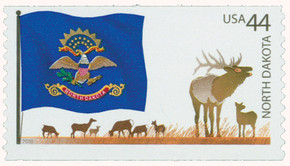
U.S. #4305
Flags of Our Nation
Nebraska
Issue Date: April 16, 2010
City: New York, NY
Printing Method: Photogravure
Perforations: Serpentine Die Cut 11 vertically
Nebraska
As homesteaders and settlers trickled into Nebraska in the 1860s, they were met by a sea of grass that stretched beyond the horizon. They had heard conflicting descriptions of Nebraska. Major Stephen Long, an early explorer in the 1820s, called the region the “Great American Desert” for its lack of trees and water. Zebulon Pike described it as having “not a stick of timber.”
Decades later, others, such as Professor Samuel Aughey and Charles Dana Wilber, described the state as a garden and declared “Rainfall follows the plow.” That claim inspired an influx of settlers, and soon Nebraska was being plowed. But the prairie grass that served as an anchor for the soil was soon buried. Heavy winds that often swept the plains dried the exposed soil into dust, then lifted it into great rolling clouds called “black blizzards.”
Droughts struck the region in the 1920s and 30s, leading to the nickname, the “Dust Bowl.” Combined with the Great Depression, it meant hard times for Nebraska. But modern farming techniques have helped restore fertility to the plains. This history is commemorated on Nebraska’s flag, which features the state seal on a blue background. The seal showcases the importance of agriculture to the state’s prosperity.














